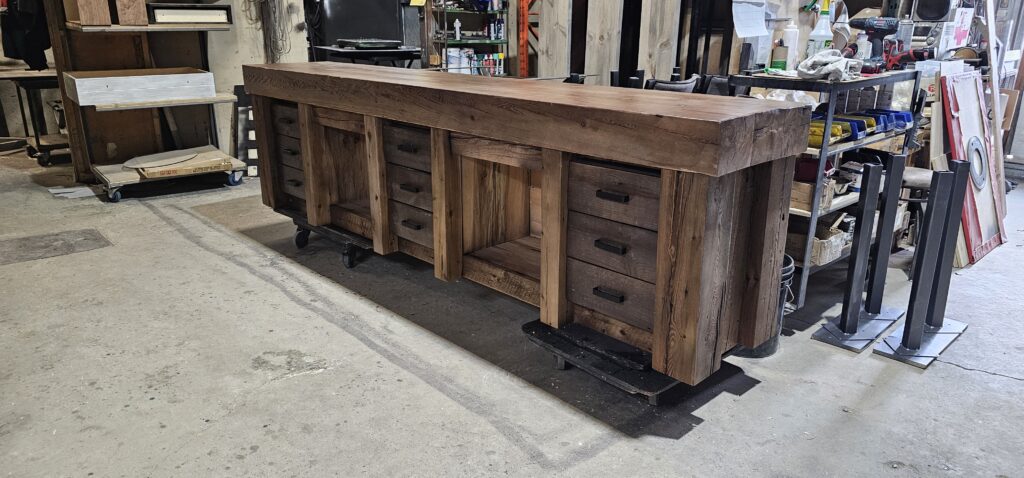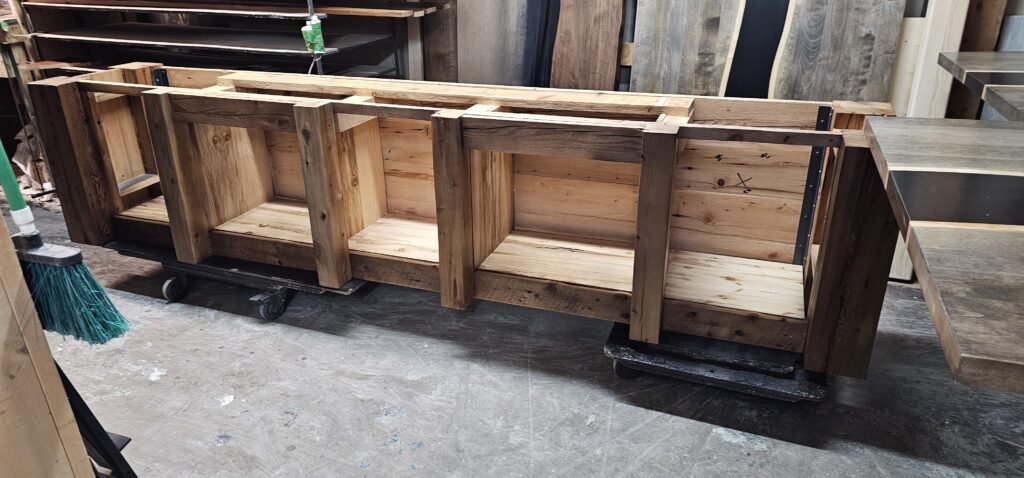Evolution of woodworking in Canada
Woodworking in Canada has come a long way since its colonial origins, evolving from traditional practices to modern innovations that meet contemporary needs.
This craft, which skilfully blends technique and creativity, bears witness to cabinetmakers’ ongoing adaptation to both local materials and advanced technologies. This article explores the fascinating history of cabinetmaking in Canada.
It highlights the skills and training needed to become a cabinetmaker today, and discusses the career prospects and benefits of this noble profession.
By following the thread of this evolution, we discover how Canadian cabinetmaking has remained relevant and valued in the modern world of interior design.
The History of Woodworking: Millennia of Know-How
Cabinetmaking, an ancient art that originated in antiquity, has evolved considerably over time. This artisanal craft mainly involves working wood to create high-quality furniture and decorative pieces.
When the first settlers arrived in North America in the 17th century, cabinetmaking took on a crucial role, particularly in Quebec, where European cabinetmakers brought their expertise to meet the needs of the new colonies.
These early cabinetmakers had to adapt to local resources, using woods such as maple, oak and pine.
Important Timeline of Woodworking in Canada
- 17th century: As soon as the French colonies were established in New France, European cabinetmakers played a key role in the construction of the first homes and furniture.
They introduced elaborate techniques such as woodturning, marquetry and mortise-and-tenon assembly. Wood, an abundant resource in the region, became one of the main materials of local production, for both utilitarian and decorative furniture.
- 18th century: Colonial cabinetmaking in Quebec is characterized by the influence of the French style, particularly during the Ancien Régime. Local cabinetmakers adapted these styles to suit settlers’ tastes and available resources.
During this period, the pieces created were both functional and of high aesthetic value, contributing to the popularity of cabinetmaking among the local bourgeoisie.
- 19th century: Industrialization marked a turning point in Canadian cabinetmaking. Economic development and the expansion of the rail network enabled furniture made in Quebec to be distributed more widely.
British and American influences mingled with French traditions, giving rise to a diversity of styles. In addition, machine tools began to be used, making furniture production faster while retaining some of the traditional craftsmanship.
- 20th century: During the 20th century, cabinetmaking in Quebec became increasingly modern. New technologies, such as the circular saw and milling machine, made cabinetmakers’ work easier, but some craftsmen continued to prefer manual techniques to preserve the quality of their work.
Cabinetmaking has become a symbol of respected craftsmanship, particularly in the high-end furniture and historic renovation sectors.
- 21st century: Today, cabinetmaking is enjoying a veritable renaissance in Quebec, in response to growing demand for custom-made, sustainable furniture. Ecological design and the use of recycled or certified sustainable materials are gaining in popularity.
Quebec cabinetmakers combine traditional techniques with modern innovations to create unique pieces that reflect a rich heritage while adapting to today’s needs.
This evolution testifies not only to the adaptability of cabinetmakers, but also to the importance of the craft in Quebec culture.
By perpetuating ancestral know-how while adapting to new technological and ecological realities, cabinetmaking remains a noble craft that’s still relevant today.
Woodworking Salaries and Rewards in Canada
In Canada, a cabinetmaker’s salary varies according to experience and region. Beginners can expect to earn around CAD 30,000 a year, while experienced and specialized cabinetmakers can earn over CAD 50,000.
This salary reflects the technical skill and creativity required in this profession.
The benefits of the Art of Cabinetmaking
Working as a cabinetmaker in Canada offers many advantages, such as the chance to work with local materials and take part in a variety of projects ranging from restoring antique furniture to creating modern custom pieces.
It’s a profession that also enables us to preserve and pass on traditional skills, while innovating to meet contemporary demands.
Becoming a cabinetmaker in Canada: Training and passion
To become a cabinetmaker in Canada, it’s advisable to follow vocational training at a technical college or school specializing in cabinetmaking.
Programs typically last two to three years and cover both traditional and new woodworking technologies.
Here’s a list of some of the schools in Quebec that offer cabinetmaking training:
1. National School of Furniture and Cabinetmaking (ENME)
- Campus Victoriaville and Montreal
- Programs DEP in cabinetmaking, DEC in craft techniques – cabinetmaking option
- Description ENME is renowned for its high-quality training in cabinetmaking, both in traditional techniques and modern innovations.
2. École d’ébénisterie d’art de Montréal
- Location Montreal
- Programs : Advanced woodworking courses
- Description The school focuses on specialized courses for professionals and enthusiastic amateurs wishing to master advanced cabinetmaking techniques.
3. Center de formation professionnelle (CFP) Mont-Laurier
- Location Mont-Laurier
- Programs DEP in cabinetmaking
- Description The CFP Mont-Laurier offers a complete DEP program in cabinetmaking, with an emphasis on the manufacture of furniture and custom parts.
4. Center de formation professionnelle (CFP) Léonard-De Vinci
- Location Saint-Laurent (Montreal)
- Programs DEP in cabinetmaking
- Description The CFP Léonard-De Vinci is well established in the field of technical training in cabinetmaking, offering a DEP recognized in the sector.
5. Center de formation professionnelle (CFP) Alma
- Location Alma
- Programs DEP in cabinetmaking
- Description This center offers a DEP program in cabinetmaking, focusing on traditional techniques and wood processing.
6. Center de formation professionnelle (CFP) de Neufchâtel
- Location Quebec City
- Programs DEP in cabinetmaking
- Description The CFP de Neufchâtel trains qualified cabinetmakers, with an approach that covers the different stages in the manufacture of furniture and other works in wood.
These schools offer a variety of programs, from DEP (Diplôme d’études professionnelles) to specialized courses, for those looking to perfect their skills or start a career in woodworking in Quebec.
The Evolution of Woodworking: Between Tradition and Modernity
Woodworking in Canada continues to develop, embracing both traditional methods and contemporary innovations.
The use of advanced technologies, such as CAD (computer-aided design) and digital manufacturing, enables Canadian cabinetmakers to create furniture that is not only functional, but also artistic and durable.
Cabinetmaking, an ancient craft, has stood the test of time, adapting to technological developments, new design trends and contemporary ecological concerns.
From traditional techniques handed down through the generations to modern innovations, this trade continues to be a real passion for those who choose to practice it.
In Quebec, numerous schools and training centers offer specialized programs, enabling aspiring cabinetmakers to learn the basics and perfect their skills in this noble art.
Whether making one-off pieces of furniture or custom-made pieces, cabinetmaking remains an essential pillar of our craft heritage, while looking resolutely to the future.
Thank you for reading
At SGL Furniture, we’re committed to delivering a quality finished product that meets your expectations. Contact us to submit your project!
See you at the next blog!
Follow us on Facebook and Instagram!


